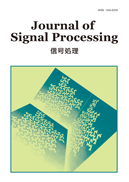
- Issue 6 Pages 147-
- Issue 5 Pages 131-
- Issue 4 Pages 99-
- Issue 3 Pages 73-
- Issue 2 Pages 39-
- Issue 1 Pages 1-
- |<
- <
- 1
- >
- >|
-
Manthana Tiawongsuwan, Leonardo Lanante, Masayuki Kurosaki, Hiroshi Oc ...2022Volume 26Issue 2 Pages 39-49
Published: March 01, 2022
Released on J-STAGE: March 01, 2022
JOURNAL FREE ACCESSIn order to meet the current transmission and QoS demands of wireless video transmission, the conventional wireless systems are using Multiple Input Multiple Output (MIMO) technology aided with receiver channel state information (CSI) feedback. The CSI is used by the access point to accurately measure the users' channel quality to decide the best transmission and video encoding parameters possible for each user. However, the CSI feedback has some disadvantages such as the delayed reception at the transmitter, the CSI expiry due to the doppler shift, and finally, hardware complexity making it difficult to be implemented in low power and low cost devices. In this paper, we propose the transmission of H.264/SVC video bitstreams through MIMO system by using the received signal strength indicator (RSSI) instead of CSI. To supplement the RSSI, we implement a look-up table based mechanism to predict the video PSNR for any wireless propagation environment. Aside from being widely supported in all wireless devices, the RSSI can be obtained from the clear to send (CTS) packets in without the need of a sounding process. The results show that our proposed method improves the PSNR by more than 16 dB, and has 6 meters more range compared with the conventional method with fixed encoding ratio and packetization.
View full abstractDownload PDF (1564K) -
Hitoshi Takata, Kazuo Komatsu2022Volume 26Issue 2 Pages 51-57
Published: March 01, 2022
Released on J-STAGE: March 01, 2022
JOURNAL FREE ACCESSThis paper is concerned with the error bounds of a pseudo-formal linearization method based on Chebyshev interpolation for nonlinear dynamic systems. First, an error bound formula is derived for a functional approximation of this linearization, in which a min-max theory is well applied to it. Then, by using this formula, another error bound formula for nonlinear dynamic systems is nicely obtained. They are more specific formulas than the general error bounds of polynomials type. Numerical experiments demonstrate the usefulness of these formulas.
View full abstractDownload PDF (805K) -
Toshihiro Matsukura2022Volume 26Issue 2 Pages 59-71
Published: March 01, 2022
Released on J-STAGE: March 01, 2022
JOURNAL FREE ACCESSVarious methods are proposed to estimate the DOA (direction of arrival) of source signal. MUSIC method uses the peak point of MUSIC spectrum to estimate DOA. The method that uses the image of video camera to estimate DOA is also proposed. Mixing matrix can be calculated by arranging the frequency transfer function calculated from DOA and separation matrix of source signal is equal to the inverse of mixing matrix. However, if the frequency range of source signal is wide, calculation accuracy of the separation matrix is worse since mixing matrix becomes adverse condition in low frequency. ILRMA can estimate wideband source signals precisely by updating signal power and separation matrix alternatively. ILRMA is characterized by learning the signal power in time-frequency domain using low rank approximation. However, if source signals are high rank, the learning error of signal power occurs in using ILRMA. To resolve these problems, this paper proposes a new method, which can improve separation accuracy by using the prior information of DOA. In this method, regularization term calculated from DOA is added to NMF's objective function. By adding this regularization term, signal power can be calculated correctly even if source signals are high rank. In order to verify the estimation accuracy of source signals in using proposed method, numerical experiment was conducted and the estimation accuracy in using proposed method was compared with that in using ILRMA under the condition that DOA was already-known. In this experiment, three source signals and six noises were mixed and three sensors received the mixed signals. The estimation accuracy of source signals by proposed method was better than ILRMA. This experimental result proves that proposed method can improve the estimation accuracy of source signals by using DOA even if source signals are high rank and exist in wideband frequency range.
View full abstractDownload PDF (1882K)
- |<
- <
- 1
- >
- >|